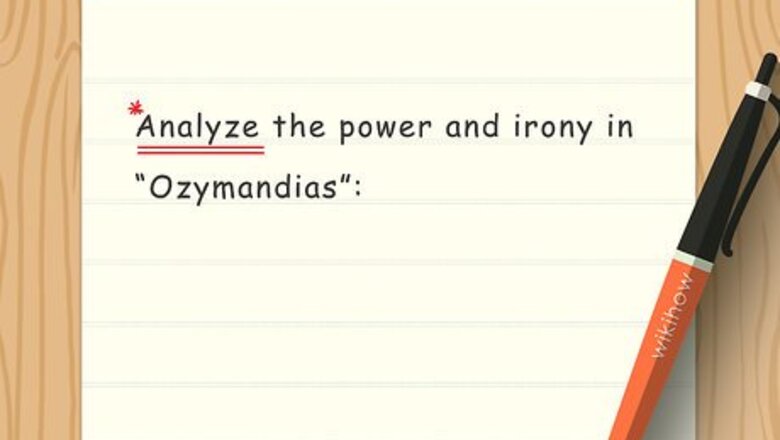
views
Following the Instructions for Your Assignment
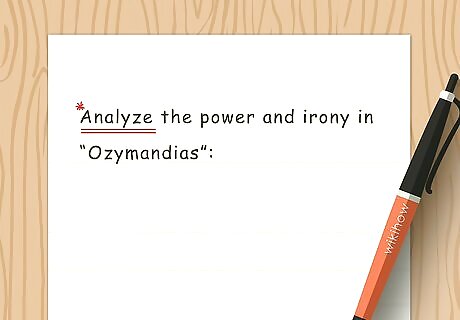
Read the instructions carefully. Before you begin working on your essay, it is crucial to understand what the assignment is about, and to learn if there are any specific rules you need to follow. Read your assignment thoroughly, and assess what you need to do. For example: Does your essay need to answer a specific question or questions? Is your essay supposed to present a critical analysis of a source, such as a book, poem, film, or work of art? Is the objective to demonstrate your ability to present an original argument based on research? Have you been asked to compare and contrast two ideas, events, or literary or artistic works?
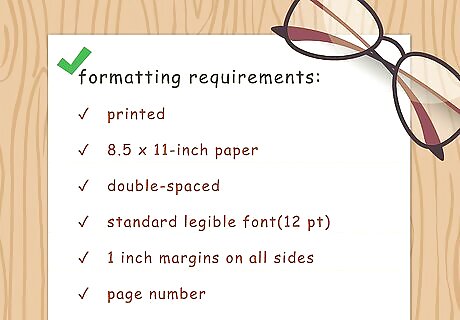
Make note of any formatting requirements. Different instructors have different expectations regarding formatting. Check your assignment carefully for formatting guidelines. These might include things like line spacing, total essay length (in words, pages, or paragraphs), font size, page numbers, or requirements for cover pages and section headings. If the formatting requirements aren’t on your assignment sheet, check the course syllabus or ask your instructor.
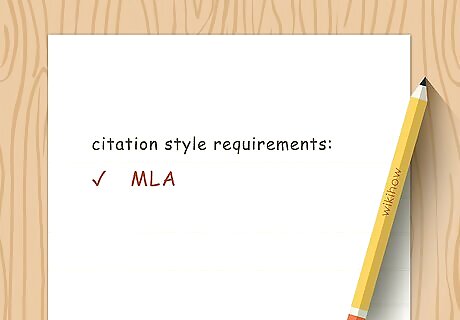
Pay attention to citation style requirements. Depending on the subject matter and the personal preferences of your instructor, you may be required to use a particular citation style. In the US, for example: Essays on subjects in the social sciences usually use APA-style citations. Essays on subjects in the humanities, such as literature or history, typically use MLA or Chicago Style. Essays on medical or health-related topics may use the AMA style, while other sciences have their own discipline-specific styles. The basic rules for most common citation styles are readily available online. For more detailed information, look for a style guide in your school library or bookstore.

Ask for clarification if you don’t understand something. Don’t be afraid to ask your instructor any questions you may have about the assignment. Most instructors are happy to explain anything that might be unclear, or offer advice on how to approach the assignment.
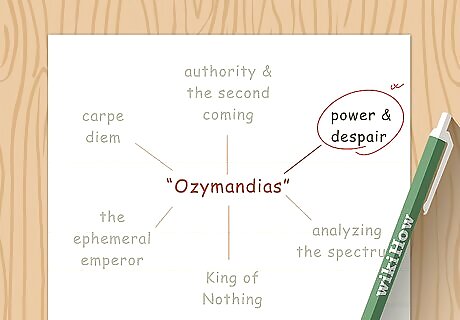
Narrow down your topic. Unless you have been given a very specific assignment, you will probably need to pick a topic to focus on. Before you start writing, figure out what the main point of your essay will be, and how you plan to approach it. Choose a topic that really interests you, or that sparks a particular question you would like to answer.
Researching Your Topic

Take advantage of your school’s resources to build your bibliography. The first step in writing an academic paper is finding good sources. Start by going to your library’s website and searching for keywords related to your topic. You can also use digital scholarly resources like WorldCat, JSTOR, Google Scholar, or ResearchGate. You may need to log in with your student ID or institutional ID to get access to many online scholarly databases, or access them through a school or library computer. Another good way to start building your bibliography is to look at the reference list on an introductory overview of your subject, such as an encyclopedia entry. Your instructor, or your school’s reference librarian, may also be able to recommend some good sources on your topic.
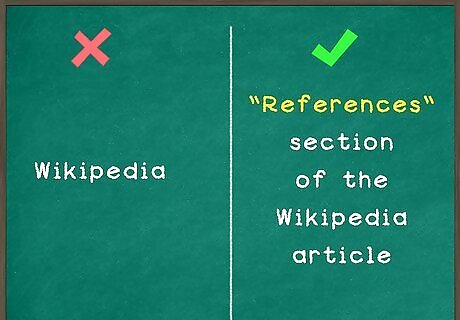
Choose appropriate sources. Look for sources that are reputable, well-sourced, and up-to-date. Ideally, most of your sources should have been published within the last 5-10 years. Scholarly books and peer-reviewed articles from academic journals are usually acceptable sources, as well as articles from reputable news organizations. Avoid popular publications and user-edited websites, such as Wikipedia. While Wikipedia is often unreliable and is not considered an appropriate source for most academic writing, it can be a good starting point for research. Check the “References” section of the Wikipedia article on your topic for useful sources.

Read your sources critically. Just because information comes from an apparently reputable source (such as a peer-reviewed journal, a scholarly book, or a news article), don’t assume that it is correct. Consider some of the following as you are doing your research: Where is the author getting their information? Do they provide credible sources? Does the author provide convincing evidence to back up their arguments? Does the author have any obvious biases or agendas that affect the way they present or interpret their information?
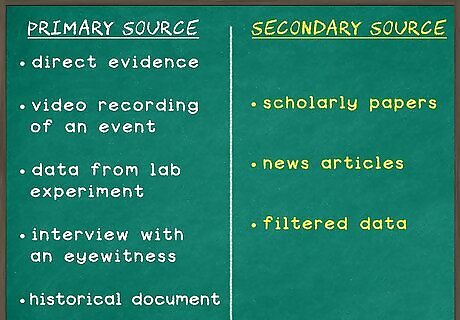
Incorporate primary sources, if applicable. A primary source is any type of first-hand or direct evidence about your topic. Depending on the subject matter, a primary source might be something like a video recording of an event, data from a laboratory experiment, an interview with an eyewitness, or a historical document, such as a monument, work of art, or memoir. When you look at secondary sources, such as scholarly papers or news articles, you are seeing the data filtered through someone else’s perspective. Looking at primary data allows you to interpret the evidence for yourself. Your instructor should specify whether you need to incorporate primary sources into your research, and if so, how to find and utilize them. If you’re not sure, ask.
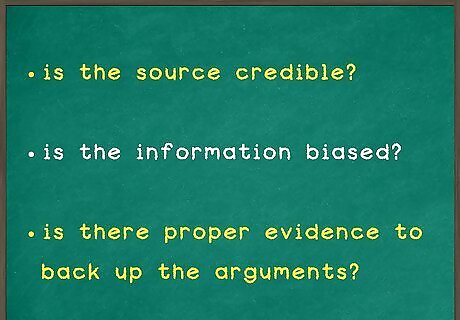
Evaluate online sources carefully. While the internet offers a vast quantity of useful information for researchers, it can be hard to separate good-quality resources from bad ones. In general, look for sources that are published on scholarly websites (such as university, library, or museum websites), by reputable news organizations (such as the BBC, NPR, or the Associated Press), or by government organizations (like the EPA or FDA). When using online articles or other online sources, also consider these questions: Are the author’s credentials given? Is the author qualified to write on the subject? Does the author state where they got their information? Are you able to verify the sources? Is the article written in an objective, unbiased manner? Is the article written for an academic audience? Is the content intended to be educational? How does the URL end? Generally, sites that end in .edu, .org, or .gov are more reputable than sites that end in .com.
Constructing Your Essay

Create a clear thesis statement. Your thesis statement is the most important part of your essay. This is where you get to explain, in clear, concise terms, the main argument that you are planning to make in your essay. State your thesis in 1-2 sentences, then work on building an outline and essay that supports your thesis. The thesis should be included toward the end of your introduction along with a brief outline of the evidence you will use to support your thesis. An example of a thesis statement is, “A growing body of evidence suggests that ‘Ode to a Tufted Titmouse’ may in fact have been written by Huffbottom’s lesser-known contemporary, Georgina Roodles. In addition to the poem’s numerous stylistic parallels to Roodles’ known works, private letters between Roodles and her brother demonstrate that she was keenly interested in ornithology at the time that ‘Tufted Titmouse’ was published.”
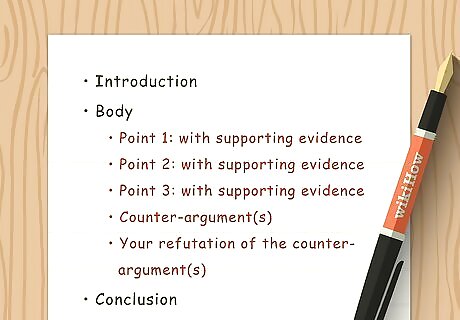
Make an outline. Once you have narrowed down your topic and done your research, start organizing your thoughts. Write a list of the most important points that you would like to touch on, in the order in which you plan to address them. The basic structure of your outline could look something like this: Introduction Body Point 1, with supporting evidence Point 2, with supporting evidence Point 3, with supporting evidence Counter-argument(s) Your refutation of the counter-argument(s) Conclusion
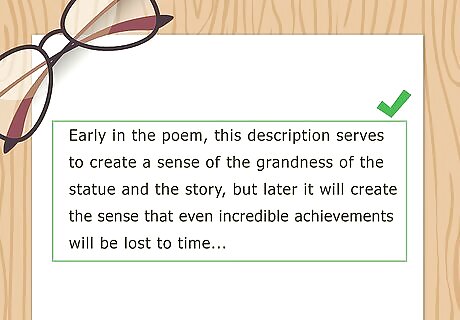
Present your argument in detail. After the introduction comes the “body” of the essay. This is the main part of the essay, consisting of several paragraphs in which you present the major arguments and evidence in support of your thesis. Each paragraph should include a “topic sentence” that clearly states the main point of the paragraph. For example: “The poem is characterized by several stylistic features that occur in numerous examples of Roodles’ work, including alliteration, humorous synecdoche, and malapropisms.”

Support each statement with examples, evidence, and an analysis. It’s not enough to simply make a claim. In order to make your argument convincing, you must provide concrete evidence and an analysis of the evidence. In each body paragraph, include a topic sentence (which is the main idea), evidence that supports the topic sentence, and an analysis of the evidence that links back to the thesis of the essay and the topic sentence of the paragraph. For example, “Compare the alliterative phrase ‘timid and tremulous twittering,’ which appears in the first stanza of ‘Ode to a Tufted Titmouse,’ with ‘mild and melodious meowing,’ which appears in the second stanza of Roodles’ 1904 poem, ‘Sadie: A Cat.’ By contrast, alliteration is almost completely absent from the contemporary works of Reginald Huffbottom.”
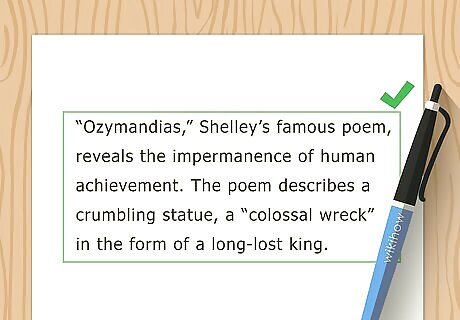
Write an introduction. Before you present the main body of your essay, you will need to provide a little background on the topic. It is often easiest to write the introduction after you have already drafted the rest of your essay. The intro doesn’t have to be an exhaustive overview – just enough information to help set the stage and tell the reader the basics of what they need to know. Your introduction should also include a clear summary of the main point of your essay, and a breakdown of how you plan to approach the topic. For example: “In 1910, an anonymous poem entitled ‘Ode to a Tufted Titmouse’ appeared in the Winter issue of Bertram’s Bogus Ballads Quarterly. The poem was eventually republished in a compilation edited by D. Travers (1934, p. 13-15), where it was attributed to Reginald Huffbottom. Several literary critics have since questioned Huffbottom’s authorship of the poem. This essay will utilize a combination of stylistic analysis and evidence from private correspondence to attempt to identify the true author of ‘Tufted Titmouse.’”

Use transitional sentences. Your essay should not feel choppy and disjointed. Look for ways to segue from one paragraph to another in a smooth, logical way. You might accomplish this by starting each paragraph with a brief sentence that connects it with the topic of the previous one (or ending each paragraph with a sentence that links it to the next). For example: “In addition to alliteration, ‘Ode to a Tufted Titmouse’ contains several examples of synecdoche, another stylistic device that occurs in several of Roodles’ earlier works.”
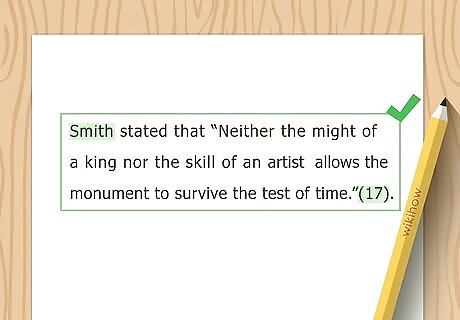
Cite your sources clearly and correctly. Any time you present information from another source, whether it’s a direct quote or a summary of someone else’s idea, it is vital that you identify the source. Follow the rules of the citation style that you are using to determine how to format each citation (e.g., with inline references, footnotes, or endnotes). Always make a clear distinction between paraphrasing (putting someone else’s statement into your own words) and quoting directly (using someone else’s exact words). If you are paraphrasing, rephrase your source’s statement or idea using your own words, but identify the source with a footnote or in-text citation. E.g.: Percival Bingley states that ‘Ode to a Tufted Titmouse’ was most stylistically similar to Roodles’ earliest work, and was unlikely to have been written later than 1906 (2015, p. 357). For short direct quotations, put the passage you’re quoting in quotation marks (“”), and identify the source immediately after the quote with a footnote or in-text citation. E.g.: In May 1908, Roodles stated in a letter to her brother that she found it “quite impossible to get a good rhyme for Bay-breasted Warbler” (Twistleton, 2010, p. 78). Longer “block quotations” (of 3 lines or more) should not be put in quotes. Instead, every line of the quote should be indented from the left-hand side.
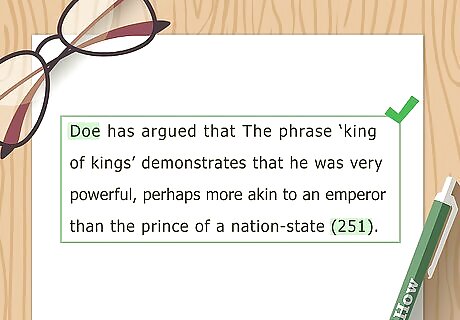
Address counterarguments. If you come across any convincing counterarguments to your thesis, acknowledge them in your essay. If you can, provide evidence to refute these counterarguments. Addressing alternative interpretations of the evidence will show that you have researched your topic thoroughly and allow you to present your case in a fair and balanced manner. Convincingly rebutting the major counterarguments will make your own argument more compelling to your readers. For example: “Vogle has argued against Roodles as a likely author of ‘Tufted Titmose’ based on the fact that none of her known works contain references to birds (2007, p. 73). However, several of Roodles’ letters to her brother, written between 1906 and 1909, refer to ‘those blasted bird poems I’ve been working on’ (Twistleton, 2010, pgs. 23-24, 35, and 78).”

Write a concluding paragraph. Once you have presented your arguments and evidence, tie everything together with a concise summary. State, in a clear and confident way, why you think that your argument successfully supports your thesis, and summarize a few of the key points or discoveries that you made. If you have any final thoughts, such as ideas for further research on the topic or questions that still need to be answered, this is the place to state them. Don’t just rehash what you wrote in your introduction. Use a few sentences to reflect on the significance of your argument, and how it might affect future studies of this topic.

Create a bibliography. Your bibliography should contain a list of every source that you made reference to in the paper, however briefly. While the format of the bibliography will vary depending on the citation style you are using, each citation should include (at minimum): The name of the author. The title of the work. The name of the publisher, and (usually) the place of publication. The date of the publication.
Polishing Your Essay

Take a break. Once you’ve finished your first draft, step away from the essay for a bit. It’s hard to look at your writing objectively when you’ve been staring at it for hours. If you can, sleep on it and come back to it the next day, so that you can look at it with a fresh perspective.

Read over your draft. As you read, look for any obvious issues with style, flow, and organization. If it helps, read the essay out loud to yourself. Make note of anything that jumps out at you as needing improvement. As you read, keep the following questions in mind: Is your writing concise? Are there any words or sentences that you could cut out? Is your writing clear? Does everything make sense? Is the essay well-organized? Is there anything that would flow better if it was arranged in a different order? Do you need to make the transitions between sections flow more smoothly?
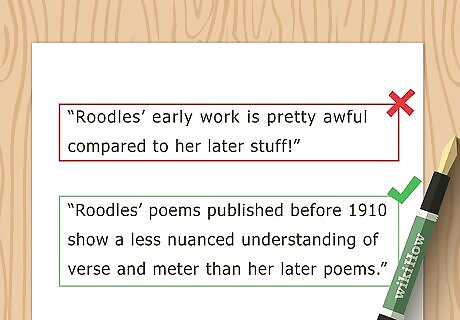
Check the language and tone of your essay. As you read over your essay, consider whether the language you use is appropriate for academic writing. Avoid slang and colloquialisms, clichés, and language that is overly emotional or judgmental. Keep your language and tone formal and objective. For example, “Roodles’ early work is pretty awful compared to her later stuff!” would not be appropriate in an academic paper. Instead, write something like, “Roodles’ poems published before 1910 show a less nuanced understanding of verse and meter than her later poems.”

Edit your essay. Once you’ve read over everything and made note of any important changes that need to be made, go through and revise your essay. When you’re done, read it over a second time. Make sure to save a copy of your previous draft separately, in case you make any major revisions and then change your mind.
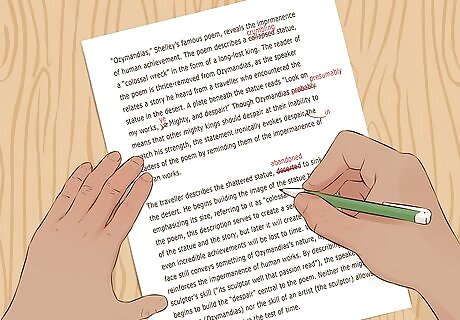
Proofread your essay. Proofreading is the nitty-gritty task of catching and correcting issues like formatting problems, typos, spelling errors, punctuation errors, and grammar mistakes. Read your essay slowly, line by line, and correct any problems that you see. Reading out loud can help you catch problems that your eye might miss when you’re reading silently.

Have someone else check your work. When it comes to revising your writing, two sets of eyes are definitely better than one. If you can, have a friend or classmate read over your essay before you finalize it and hand it in. They may catch errors that you missed, or point out passages that need to be clarified or reworded.


















Comments
0 comment